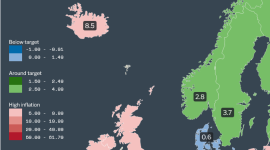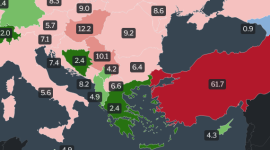With winter still reigning in the northern hemisphere, I look at how the word “snow” is written in different European languages and visualize it on the map of Europe while exploring its etymological roots and their meanings. While some of the results are expected, there are some interesting and exciting outlier cases! So, let’s go and explore what the word snow in different languages of Europe looks like!
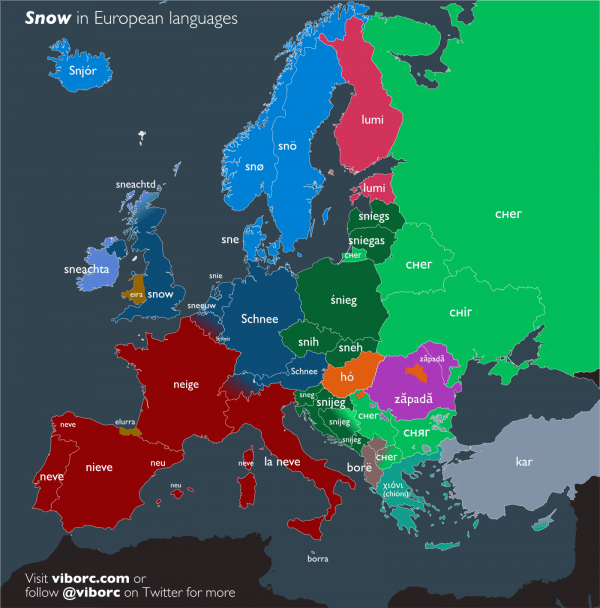
Slavic, Germanic, and Romance languages
Naturally, similarities are noticeable within the same language families – for example, Slavic countries use using words “snijeg“, “sneg”, “snih” or “снег” for snow in different languages.
Germanic countries are using variants like “Schnee“, “snee” and “snije” – there are some differences between the groups, so you can clearly see that words from Danish, Swedish, Norwegian, and even Icelandic, are more similar among themselves.
Germanic and (Balto-)Slavic origin is probably from the Proto-Indo-European word “*sneygʷʰ-“.
Romance languages use variants like “neige”, “nieve“, “neve” – with the notable exception of the Romanian language, which uses the word “zăpadă” – similar to the Slavic verb meaning “to fall” (zapadati, napadati). However, I just learned, thanks to Reddit user jondevries, that the word “nea” is also used, especially in expressions like “fulgi de nea” (snowflakes).
Origins of the Romanesque variants are seemingly related to Latin nix, nivem (meaning “snow”).
Outliers: Basque, Hungarian, Turkish, Greek…
However, there are several interesting outliers on the map.
Basque language
Basque language word for snow is “elurra/elura” and it originates from the From Proto-Basque *eɫhur̄,
What intrigued me was the apparent similarity between the Basque language “elurra” and the Welsh word “eira”. However, it seems that there is no real relationship. It seems that Welsh “eira” is derived from Proto-Brythonic *argyos (“snow”) and Proto-Celtic *argyos (meaning “white”), originating from the same stem as *argantom ( meaning “silver”).
Hungarian language
Hungarian word “hó” has at least two possible etymological roots. The first one is from Proto-Uralic *kume ( meaning “thin snow”). And the second one is from Proto-Uralic *kuŋe. That resembles the modern-day Hungarian word “hold” (meaning “moon”). Since the Moon is silver/white, it can add to the perception of the snow. It also relates to the Estonian and Finnish word “kuu“ which means “snow”, but it was also the name of the mythical Finnish goddess of Moon.
Greek language
The Greek word “χιόνι” is derived from the Ancient Greek word “χιών” (read as “khiṓn” and meaning “snow”).
Turkish language
The Turkish word “kar” comes from the Old Turkic ?? (read as “kar” and meaning “snow”). It is also related to Proto-Turkic *kār, *Kiār (again, meaning “snow”) and possibly to Proto-Altaic *k`i̯ā́ra (*k`i̯ā́ra) (meaning “hoarfrost”). Literature sources suggest a possible relationship with Proto-Mongolic *karig (meaning “strong coldness”).
Albanian and Maltese languages
Albanian word “borë” derives from Proto-Albanian *bārā, from *bera (meaning “to fall”). What intrigued me here was the fact that Albanian “borë” appears to be similar to the Maltese language word “borra”. It is interesting that the Maltese language is the only official Semitic language in the European Union. The language itself originated from the Siculo-Arabic, the extinct variety of Arabic language. However, the concrete etymology of the word “borra” is not clear. And all that remains is the possibly coincidental resemblance to the aforementioned Albanian “borë”.
Croatian “bura”?
Also, there are no etymological relations between “borë” and “borra” with the Croatian word “bura“ (meaning “bora”; for strong wind). Croatian “bora” originates from the Proto-Slavic *bur’a.
According to Wiktionary, interesting non-Slavic cognates include Old Norse “byrr“ (meaning “fair wind”), Latin “furō” (meaning “I rage, rave” – similar to English “furious”), and Sanskrit भुरति (bhurati, meaning “to stir, palpitate”). Very interesting perspective and how the word snow came to be in different European languages.
Map with etymological focus – putting together countries and languages based on their “true” etymological origin
When I posted the link to this article on Twitter, Bojan Glavašević, a Croatian linguist and a politician, gave me an idea. He suggested that he would color the map a bit differently, taking into account the original etymology of the words.
I considered his suggestion and created a new map. So, here it is for your viewing pleasure.
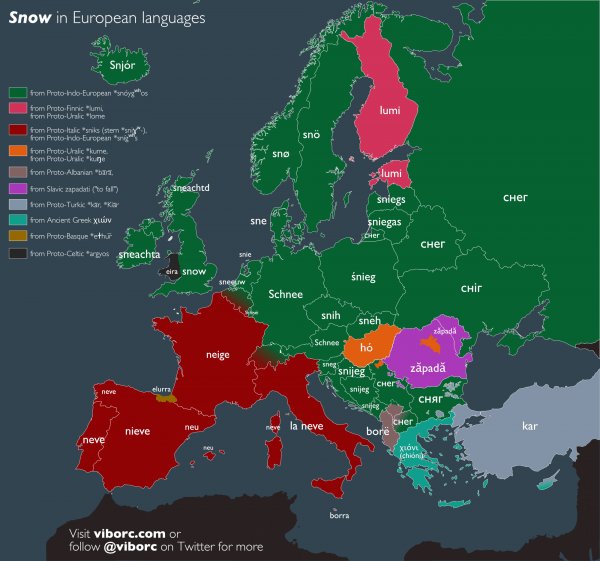
Keep in mind that even the red parts of the map could be colored green since the variants of “neve“, “neige“, “neu” – originate from the common Latin word “nix”, “nivis”. Whereas “nix” originates from the Proto-Italic *sniks (stem *sniɣʷ-) and Proto-Indo-European *snígʷʰs.
Pretty cool, right?
Feeling cold?
You can check how the month of May is written in different languages or maybe, to warm up a bit more, learn about the highest temperature ever recorded on Earth.
ABOUT THE AUTHOR
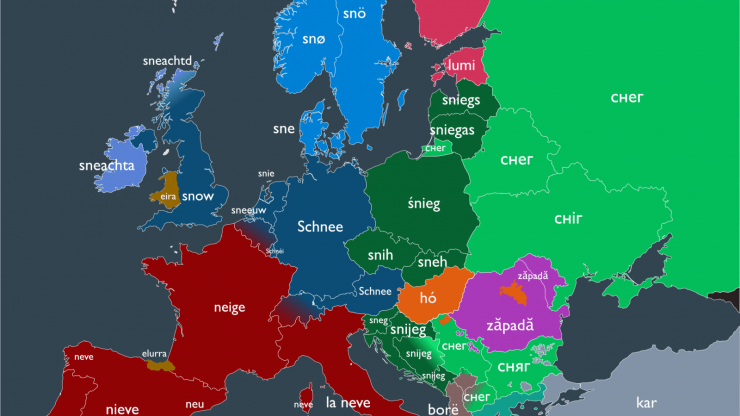 Word "snow" written in different European languages. Snow in different languages of Europe.
Word "snow" written in different European languages. Snow in different languages of Europe.



